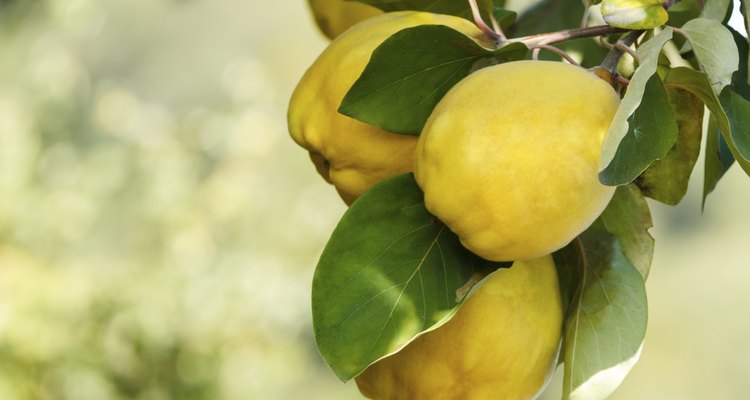
Slavica Stajic/iStock/Getty Images
As a group, quince trees (Cydonia oblonga) are hardy in U.S. Department of Agriculture plant hardiness zones 5 to 9. The small trees rarely exceed 15 feet, and they develop an intriguingly twisted silhouette withing a few years. Most can be pruned to bushes that stand about 8 feet tall. Depending on the variety, quince fruit can be rounded or pear-shaped, with a yellowish to orange exterior, and flesh color that also depends upon which kind you are growing. Quince trees do best in full sun with moist, rich soil, but they often tolerate poor soil conditions.
Choosing Your Quince Tree
Part of deciding which quince tree to grow may depend upon your preferences regarding the fruit itself. For prettier desserts, you might want to choose 'Van Deman' (USDA zones 5 to 10), which turns red when heated. On the other hand, if you are in a more temperate climate, 'Smyrna' might be your best bet because it requires fewer chill hours. Chill hours refers to the amount of time your area experiences temperatures between 32 and 45 degrees Fahrenheit. The range for the fruiting quince tree group is 300 to 500 chill hours.
Popular Quince Varieties
'Van Deman' (USDA zones 5 to 10) is an early-fall quince variety with orange skin and somewhat grainy flesh. 'Van Deman' requires more chill hours than 'Orange.'
'Orange' (USDA zones 5 to 8) is named for its flesh color, not its exterior. Another early-fall variety, 'Orange' also has an intense flavor, large size and yellow skin.
'Pineapple' (USDA zones 5 to 9), as its name suggests, boasts a flavor reminiscent of that tropical fruit. The yellow-skinned quince variety has a white exterior. 'Pineapple' is a low-chill fruit that ripens mid-fall.
'Smyrna' (USDA zones 5 to 10) has light brown fuzz covering yellow skin. 'Smyrna' is known for its tender interior and large size. The mid-fall quince is one of the low-chill varieties.
'Champion' (USDA zones 5 to 9), also a mid-fall quince, requires more chill hours than 'Pineapple' or 'Smyrna.' Looking much like a large pear in terms of its shape, 'Champion' has light green flesh.
Quince Confusion
Quince trees have near-relatives in ornamental shrubs that are known as flowering quince (Chaenomeles speciosa) and Japanese quince (Chaenomeles japonica). Like fruiting quince, flowering and Japanese quince produce fruits. These slightly edible fruits are not to be confused with the fruit most commonly known as quince, from the Cydonia oblonga trees. Flowering quince and Japanese quince are low-growing shrubs, notable for their early-blooming flowers. They're available in a variety of bloom colors. Flowering quince cultivars include 'Contorta,' for USDA zones 4 to 8, and 'Scarlet Storm,' hardy in USDA zones 5 to 9. Japanese quince and its cultivars are generally perennial in USDA zones 5 to 9.
Related Articles
When Is Grapefruit Season in Florida?

Are Buckeyes & Chestnuts the Same?

How to Eat a Quince

Types of Greek Fruits & Vegetables
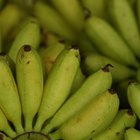
List of Tropical Fruits
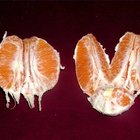
Information About the Orange Fruit

Places to Pick Wild Blueberries in ...
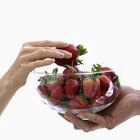
Information About Strawberries for Kids

How to Eat a Kiwano Horned Melon
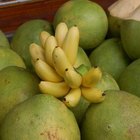
Foods From Rainforest Plants
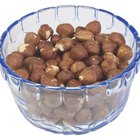
What Kinds of Nuts Don't Grow on Trees?
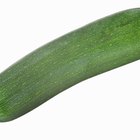
Calories in a Large Zucchini

The History of Butternut Squash

Can You Peel and Refrigerate Bananas ...

Fruits or Vegetables Starting With X

How to Grill Chayote Squash

Can You Use an Eggplant if It Has ...

Difference Between Clover & Orange ...

When to Harvest Sweet Meat Squash?

Orange Juice & Fiber
Writer Bio
Ellen Douglas has written on food, gardening, education and the arts since 1992. Douglas has worked as a staff reporter for the Lakeville Journal newspaper group. Previously, she served as a communication specialist in the nonprofit field. She received her Bachelor of Arts from the University of Connecticut.